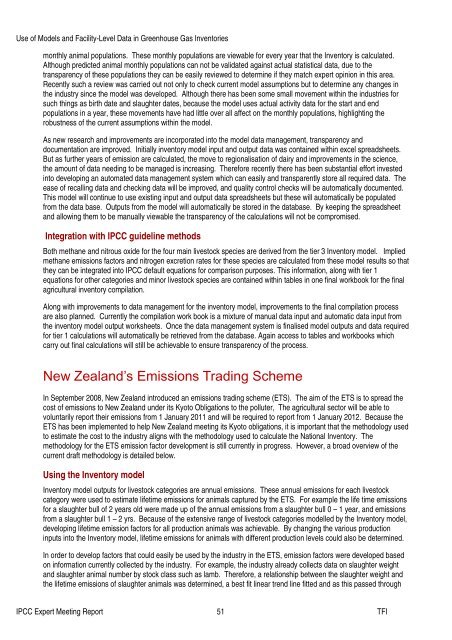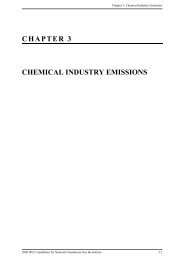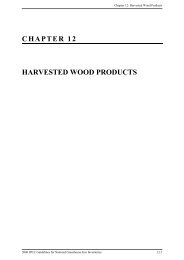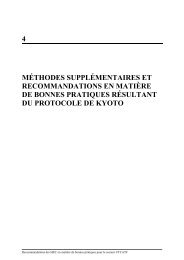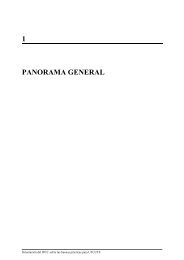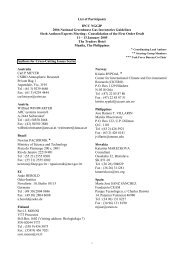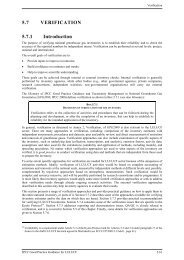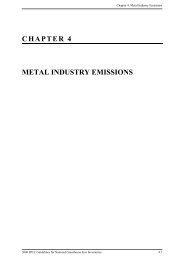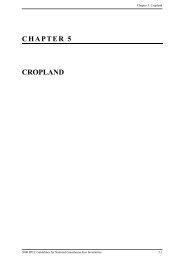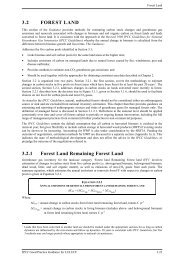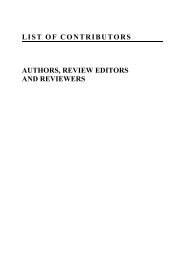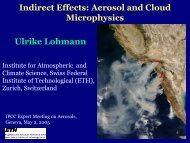Use of Models and Facility-Level Data in Greenhouse Gas Inventories
Use of Models and Facility-Level Data in Greenhouse Gas Inventories
Use of Models and Facility-Level Data in Greenhouse Gas Inventories
Create successful ePaper yourself
Turn your PDF publications into a flip-book with our unique Google optimized e-Paper software.
<strong>Use</strong> <strong>of</strong> <strong>Models</strong> <strong>and</strong> <strong>Facility</strong>-<strong>Level</strong> <strong>Data</strong> <strong>in</strong> <strong>Greenhouse</strong> <strong>Gas</strong> <strong>Inventories</strong><br />
monthly animal populations. These monthly populations are viewable for every year that the Inventory is calculated.<br />
Although predicted animal monthly populations can not be validated aga<strong>in</strong>st actual statistical data, due to the<br />
transparency <strong>of</strong> these populations they can be easily reviewed to determ<strong>in</strong>e if they match expert op<strong>in</strong>ion <strong>in</strong> this area.<br />
Recently such a review was carried out not only to check current model assumptions but to determ<strong>in</strong>e any changes <strong>in</strong><br />
the <strong>in</strong>dustry s<strong>in</strong>ce the model was developed. Although there has been some small movement with<strong>in</strong> the <strong>in</strong>dustries for<br />
such th<strong>in</strong>gs as birth date <strong>and</strong> slaughter dates, because the model uses actual activity data for the start <strong>and</strong> end<br />
populations <strong>in</strong> a year, these movements have had little over all affect on the monthly populations, highlight<strong>in</strong>g the<br />
robustness <strong>of</strong> the current assumptions with<strong>in</strong> the model.<br />
As new research <strong>and</strong> improvements are <strong>in</strong>corporated <strong>in</strong>to the model data management, transparency <strong>and</strong><br />
documentation are improved. Initially <strong>in</strong>ventory model <strong>in</strong>put <strong>and</strong> output data was conta<strong>in</strong>ed with<strong>in</strong> excel spreadsheets.<br />
But as further years <strong>of</strong> emission are calculated, the move to regionalisation <strong>of</strong> dairy <strong>and</strong> improvements <strong>in</strong> the science,<br />
the amount <strong>of</strong> data need<strong>in</strong>g to be managed is <strong>in</strong>creas<strong>in</strong>g. Therefore recently there has been substantial effort <strong>in</strong>vested<br />
<strong>in</strong>to develop<strong>in</strong>g an automated data management system which can easily <strong>and</strong> transparently store all required data. The<br />
ease <strong>of</strong> recall<strong>in</strong>g data <strong>and</strong> check<strong>in</strong>g data will be improved, <strong>and</strong> quality control checks will be automatically documented.<br />
This model will cont<strong>in</strong>ue to use exist<strong>in</strong>g <strong>in</strong>put <strong>and</strong> output data spreadsheets but these will automatically be populated<br />
from the data base. Outputs from the model will automatically be stored <strong>in</strong> the database. By keep<strong>in</strong>g the spreadsheet<br />
<strong>and</strong> allow<strong>in</strong>g them to be manually viewable the transparency <strong>of</strong> the calculations will not be compromised.<br />
Integration with IPCC guidel<strong>in</strong>e methods<br />
Both methane <strong>and</strong> nitrous oxide for the four ma<strong>in</strong> livestock species are derived from the tier 3 Inventory model. Implied<br />
methane emissions factors <strong>and</strong> nitrogen excretion rates for these species are calculated from these model results so that<br />
they can be <strong>in</strong>tegrated <strong>in</strong>to IPCC default equations for comparison purposes. This <strong>in</strong>formation, along with tier 1<br />
equations for other categories <strong>and</strong> m<strong>in</strong>or livestock species are conta<strong>in</strong>ed with<strong>in</strong> tables <strong>in</strong> one f<strong>in</strong>al workbook for the f<strong>in</strong>al<br />
agricultural <strong>in</strong>ventory compilation.<br />
Along with improvements to data management for the <strong>in</strong>ventory model, improvements to the f<strong>in</strong>al compilation process<br />
are also planned. Currently the compilation work book is a mixture <strong>of</strong> manual data <strong>in</strong>put <strong>and</strong> automatic data <strong>in</strong>put from<br />
the <strong>in</strong>ventory model output worksheets. Once the data management system is f<strong>in</strong>alised model outputs <strong>and</strong> data required<br />
for tier 1 calculations will automatically be retrieved from the database. Aga<strong>in</strong> access to tables <strong>and</strong> workbooks which<br />
carry out f<strong>in</strong>al calculations will still be achievable to ensure transparency <strong>of</strong> the process.<br />
New Zeal<strong>and</strong>’s Emissions Trad<strong>in</strong>g Scheme<br />
In September 2008, New Zeal<strong>and</strong> <strong>in</strong>troduced an emissions trad<strong>in</strong>g scheme (ETS). The aim <strong>of</strong> the ETS is to spread the<br />
cost <strong>of</strong> emissions to New Zeal<strong>and</strong> under its Kyoto Obligations to the polluter, The agricultural sector will be able to<br />
voluntarily report their emissions from 1 January 2011 <strong>and</strong> will be required to report from 1 January 2012. Because the<br />
ETS has been implemented to help New Zeal<strong>and</strong> meet<strong>in</strong>g its Kyoto obligations, it is important that the methodology used<br />
to estimate the cost to the <strong>in</strong>dustry aligns with the methodology used to calculate the National Inventory. The<br />
methodology for the ETS emission factor development is still currently <strong>in</strong> progress. However, a broad overview <strong>of</strong> the<br />
current draft methodology is detailed below.<br />
Us<strong>in</strong>g the Inventory model<br />
Inventory model outputs for livestock categories are annual emissions. These annual emissions for each livestock<br />
category were used to estimate lifetime emissions for animals captured by the ETS. For example the life time emissions<br />
for a slaughter bull <strong>of</strong> 2 years old were made up <strong>of</strong> the annual emissions from a slaughter bull 0 – 1 year, <strong>and</strong> emissions<br />
from a slaughter bull 1 – 2 yrs. Because <strong>of</strong> the extensive range <strong>of</strong> livestock categories modelled by the Inventory model,<br />
develop<strong>in</strong>g lifetime emission factors for all production animals was achievable. By chang<strong>in</strong>g the various production<br />
<strong>in</strong>puts <strong>in</strong>to the Inventory model, lifetime emissions for animals with different production levels could also be determ<strong>in</strong>ed.<br />
In order to develop factors that could easily be used by the <strong>in</strong>dustry <strong>in</strong> the ETS, emission factors were developed based<br />
on <strong>in</strong>formation currently collected by the <strong>in</strong>dustry. For example, the <strong>in</strong>dustry already collects data on slaughter weight<br />
<strong>and</strong> slaughter animal number by stock class such as lamb. Therefore, a relationship between the slaughter weight <strong>and</strong><br />
the lifetime emissions <strong>of</strong> slaughter animals was determ<strong>in</strong>ed, a best fit l<strong>in</strong>ear trend l<strong>in</strong>e fitted <strong>and</strong> as this passed through<br />
IPCC Expert Meet<strong>in</strong>g Report 51 TFI


